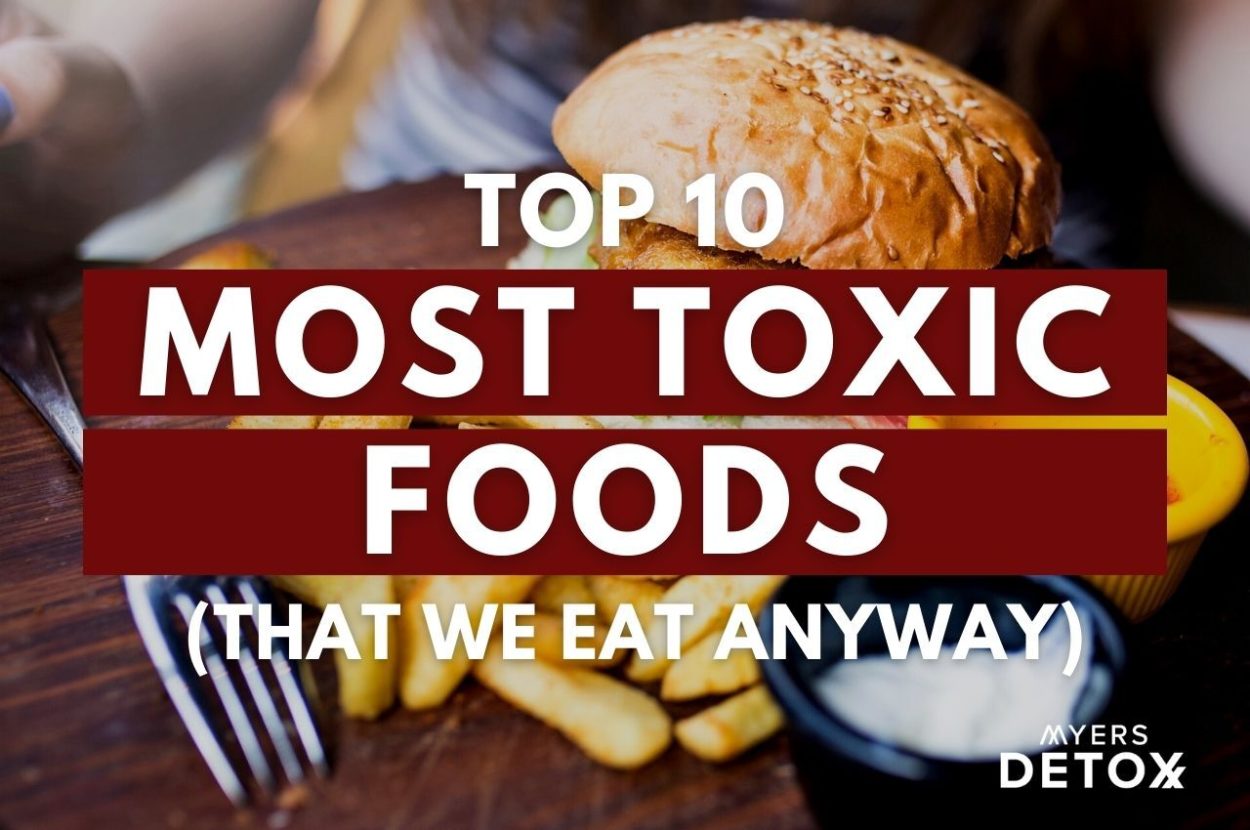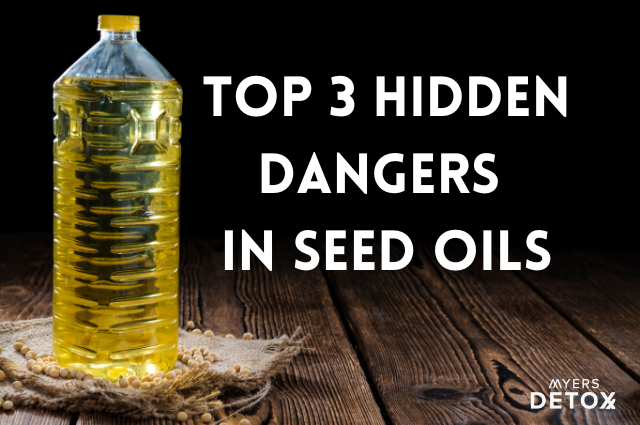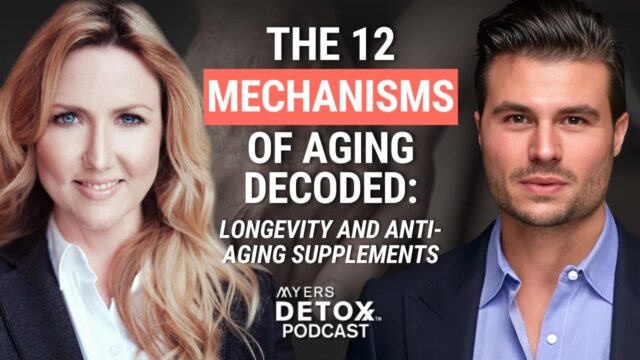Is the food you eat toxic? If you live in the US and shop at most grocery stores, the answer is probably yes.
A hundred years ago, there would be a clear delineation between a food that was bad for your health and one that supports health. In today’s food landscape, however, it can be hard to tell the difference.
Many toxic foods get a “health halo,” leading innocent consumers to astray, and the result is debilitating health problems and chronic disease.
Before your next shopping trip, assess whether you’ve been incorporating the below top ten most toxic foods into your diet.
In this article, you’ll learn:
- How the food you eat is damaging your liver
- Why replacement sugars are more dangerous than sugar itself
- Why “eating a rainbow a day” doesn’t mean what it used to
- How the richest sources of omega-3s are also pumping you full of heavy metals
- The top 10 most toxic foods
- And more
Top 10 Most Toxic Foods
#1 Alcohol

It may not be a food, but alcohol is inarguably toxic to the body and is one of the most frequently used substances worldwide. Excessive alcohol consumption can lead to fatty liver, liver fibrosis, and when left untreated, cirrhosis of the liver.
When your liver gets to the stage of cirrhosis, it can no longer function at full capacity[1].
Your liver is responsible for over 500 functions and plays a crucial role in detoxification. Therefore, when your liver takes a hit, your entire body feels the effects.
Although it may feel nice to have a few drinks, alcohol itself is a toxin — that’s why we feel so funny when we drink it. Does this mean you should never drink? No. But watching your intake is crucial[2].
#2 High-Fructose Corn Syrup
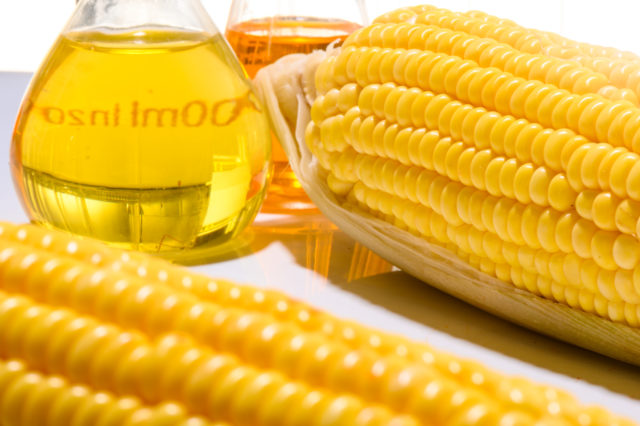
High-fructose corn syrup (HFCS) is linked to a number of chronic diseases, specifically metabolic conditions like diabetes and heart disease[3].
The problem is that when you consume HFCS, your liver has to deal with very high blood sugar. Over time this can cause inflammation, weight gain, damage your liver and promote diabetes, among other health issues.
HFCS is also contaminated with mercury and glyphosate, which adds to your toxic body burden and more garbage for your liver to detox.
We see HFCS used as a sweetener in processed foods like candy, soda, ice cream, and so on. Why is this sweetener so popular? It’s incredibly cheap and easy to work with from a manufacturing standpoint.
The problem is, HFCS introduces an unprecedented amount of fructose into your body at one time. Traditionally, we would only consume fructose in small amounts from fruit and other sweeteners like honey or molasses. Unlike glucose, which can be absorbed easily and taken up by your cells to be used as fuel, fructose has to be converted into glucose by your liver.
This means that when you consume HFCS, your liver gets bombarded with work all at once, which means some of that fructose goes into storage as fat instead of getting transformed into fuel.
Do this once in a while, and it’s no big deal. Consume HFCS regularly, however, and you may start to cause damage to your liver[4].
#3 Sugar

HFCS and white sugar have many of the same risks associated with them because they’re both high in fructose. Although HFCS may have more fructose, white sugar is actually just another name for sucrose, which is a disaccharide (containing two sugar units) made up of glucose and fructose. Therefore, 50% of table sugar is fructose.
Just like HFCS, excess sugar (or cane sugar) consumption is associated with fatty liver, diabetes and heart disease[4].
But fructose isn’t the only culprit behind sugars’ bad rap. Due to the rapid breakdown and subsequent absorption of the glucose in sugar, it can cause hyperglycemia (too much sugar in the blood), which is associated with something called AGES (advanced glycation end products)[5].
AGES are formed when a protein or fat molecule combines with a glucose molecule, making them “glycated.” These glycated AGES then go on to create high levels ofwardsoxidation and inflammation in your body. Eventually, they can lead to tissue damage and promote the development of chronic diseases like diabetes and heart disease[6][7].
#4 Fish

Not all toxic foods are as obvious as sugar and alcohol. Fish, which is an excellent source of omega-3 fatty acids, is also, unfortunately, an excellent source of heavy metals.
In fact, research shows that some of the fish sold in supermarkets in the US contain high levels of arsenic, lead and mercury[8].
While some types of fish contain higher levels of toxins than others, the toxicity of our oceans today has contaminated the majority of fish that live in it.
In addition to heavy metals like mercury, fish are also subject to radioactive fallout from nuclear accidents. This is something that most authorities don’t talk about and will sweep under the rug — but the risk is very real.
In fact, Japan is still dealing with cesium-contaminated water from the Fukushima nuclear disaster that happened over 10 years ago! This toxic water is being pumped daily into our oceans and getting into the fish supply.
Cesium can cause damage to your cells, interfere with the function of potassium, which can cause cramps and heart palpitations, and interfere with your mitochondria energy production, causing fatigue[10].
I still recommend eating fish. It’s a very healthy food and you can take steps towards making smart seafood choices. I also recommend supporting your body’s natural ability to detox on a regular basis to remove metals and toxins we get in all foods – even vegetables!
#5 Rice
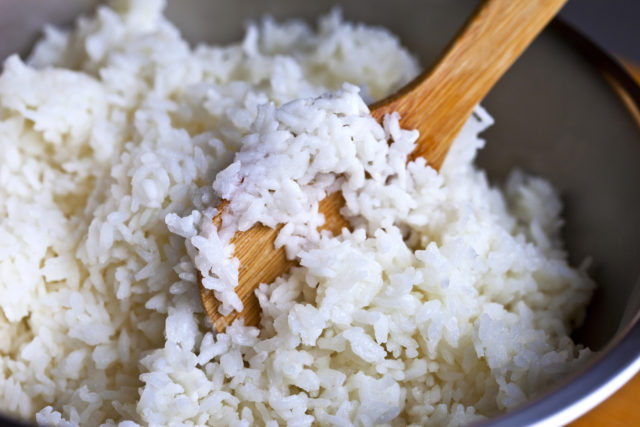
Rice is a staple in many people’s diets. It’s a cornerstone of cuisines around the world —
Thai, Chinese, Mexican, Indian.
Unfortunately, consumer reports warn that levels of the heavy metal arsenic in rice are dangerously high. Specifically, rice has been found to contain toxic amounts of inorganic arsenic, which is considered a carcinogen. Exposure to inorganic arsenic is also associated with damage to several areas of the body, including[11][12]:
- Gastrointestinal
- Neurological
- Cardiovascular
- Immunological
- Pulmonary
- Reproductive and developmental
I eat organic, white rice as this type of rice will have the least contaminants. Brown rice will harbor the most contaminants because the heavy metals like arsenic and other potential toxins are stored primarily in the bran – the brown part of the rice. That totally works for me because I don’t really like brown rice anyways!
The good news is, the gluten-free grains amaranth, buckwheat, millet, polenta and even “riced” cauliflower have negligible levels of inorganic arsenic — so go with those if you’re looking for a rice replacement[13].
#6 Conventional Beef
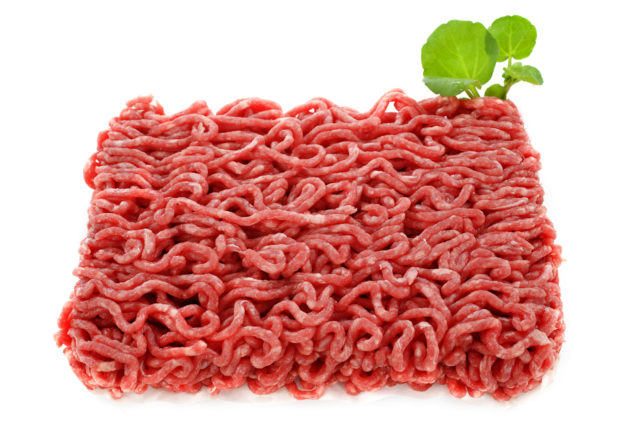
The common message around beef is to stay away from red meat because it can cause heart disease.
While that debate is much more complicated than it sounds, one thing is for sure — conventionally raised beef is toxic.
First, let’s talk about the difference between conventionally raised cattle and cattle that are allowed to roam around on a pasture.
Pasture-raised cows are allowed to move around as they please, eat grass when they’re hungry, and generally live a high-quality life on the farm. As a result, grass-fed beef is higher in healthy fats like omega-3 fatty acids and CLA (conjugated linoleic acid)[14].
On the other hand, conventionally raised cows are crammed into small liver quarters and fed low-quality animal feed that contains grains and likely other GMO ingredients. The small living quarters means that disease can run rampant, so these cows are given antibiotics to stave off infection. And the grains that they’re fed, which are meant to fatten them up, can cause severe digestive issues[15].
The result? This beef is much higher in inflammatory omega 6 fats, the fat in the meat can be full of glyphosate and pesticides and are pumped full of antibiotics, which then negatively affect your hormones and your gut microbiome, killing off healthy gut bugs.
#7 Conventional Dairy

Conventional dairy comes up against similar issues as conventional beef; except this time, the problem is hormones.
To maximize the amount of milk cows can produce, many conventional dairy farmers will pump their cows with synthetic hormones. These hormones interfere in your body’s hormones when you consume it.
Recombinant bovine somatotropin rBST, also known as synthetic bovine growth hormone, is FDA-approved, and unless your bottle of milk directly states that rBST is NOT in there, you can assume that it is.
Not surprisingly, rBST is banned in several countries due to the detrimental health effects it has on cows and serious concerns around human health[16].
In a study conducted in 2019, researchers found upwards of 20 times more growth hormone in conventional dairy when compared with organic. Furthermore, levels of antibiotics in conventional dairy exceeded federal limits in multiple samples tested[17].
The primary concern with rBST is its potential impact on the endocrine system. As a hormone, rBST may mess with the delicate balance of hormones in your body and create serious endocrine disruption.
In cows that are administered rBST unhealthy changes in hormones like insulin-like growth factor, estrogen, and progesterone lead to issues with growth and development[30].
Perhaps even more frightening is the research that suggests a link between rBST and breast cancer[33]. While the conventional dairy industry may do a good job of keeping researchers at bay, studies show a correlation between rBST consumption and increased levels of the hormone IGF-1 (insulin-like growth factor). Why does this matter? High levels of IGF-1 are linked to breast cancer in both post and premenopausal women[31][32].
If you’re going to eat dairy, you need to choose products that are organic and preferably grass-fed or pastured AND RAW to avoid consuming pesticides and antibiotics and get the most nutritious dairy possible. I know that’s a tall order.
I also recommended checking out this article, “Are You the Half That Should Avoid Dairy?”
#8 Fried Food

Fried food is the number one source of trans fat in the American diet. While very small amounts of trans fats can be found in nature, the concentration of trans fat found in fried food is beyond what the human body should ever consume.
Trans fat is a type of highly inflammatory, unsaturated fat that your body can confuse with healthy fats. Your body incorporates these deadly trans fats into your cells and even worse, your brain cells, which are comprised mostly of fat. This is akin to putting plastic into your cells and hardens your cells and cell membranes. This causes damage to the cell, which can impact cellular function, communication, and downstream processes like hormone signaling[18].
Most fried food is cooked in highly processed vegetable oils like soybean or canola oil. During the processing of these oils, trans fats are produced, which makes them more heat stable[19].
Furthermore, the process of frying food in high heat can create even more trans fats, which is why fried food is such a hotbed for these dangerous fats[20].
Additionally, the way that these trans fats are produced infuses them with nickel, which is a toxic heavy metal. If you’ve consumed trans fats in processed foods and fast foods for years, or even decades, you’ll have a high build up of nickel in your body.
Most fried food is cooked in highly processed rancid vegetable oils like GMO soybean or canola oil, that are full of pesticides and herbicides, like glyphosate.
Furthermore, the process of frying food in high heat can create acrylamides, which is a carcinogen, which is why fried food is such a hotbed for health issues.
Studies have linked trans fat consumption to inflammation, high levels of LDL cholesterol, heart disease, fatty liver disease and oxidative stress[21][22][23].
#9 Diet Soda

When most people realize how toxic soda is due to the high-fructose corn syrup, they make the next obvious choice — diet soda.
Unfortunately, diet soda is just as bad, if not worse, than regular soda.
First, all soda contains artificial coloring that can be damaging to your health. Coke and Pepsi include caramel coloring that makes them brown, resembling real caramel — but in reality, it’s nothing of the sort.
The chemical name for “caramel coloring” is 4-methylimidazole (4-MeI), which has been identified as a potential carcinogen despite the FDA’s approval[24].
Furthermore, diet soda replaces sugar with artificial sweetener aspartame.
Research shows that despite the fact that it’s not a source of glucose, aspartame may promote obesity anyway due to its impact on gut bacteria and insulin resistance[25].
Even more disturbing, this artificial sweetener has been linked to a host of neurological problems, including learning problems, headaches, seizures, migraines, irritable moods, anxiety, depression, and insomnia.
It’s hypothesized that aspartame can increase the release of compounds in your brain that inhibit the synthesis of neurotransmitters like dopamine, norepinephrine, and serotonin, which are crucial for neurophysiological activity[26].
#10 Cereal
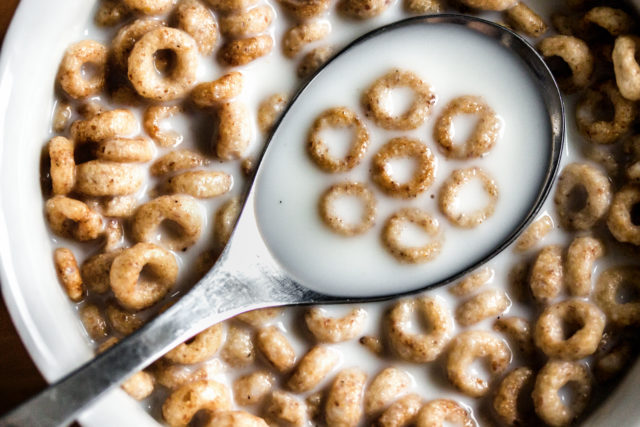
Cereal is a hotbed for toxic compounds.
Of course, not all cereal is created equal, but most of the cereal you’ll find on the shelves contain high levels of sugar, glyphosate and pesticides (even the “healthy” ones).
And the ones that aren’t trying to masquerade as healthy are loaded with preservatives, artificial colors, and artificial flavors.
Synthetic food colors, like those found in brightly-colored cereals, are associated with behavioral issues in children like ADD and ADHD[27].
Meanwhile, preservatives like butylated hydroxyanisole (BHA) and butylated hydroxytoluene (BHT) are often added to prolong shelf life and stabilize fats. The problem? They’re potential carcinogens and endocrine disruptors[28].
Furthermore, the Environmental Working Group found toxic levels of Roundup (a toxic weed killer also known as glyphosate) in popular oat-based cereals including Cheerios, Quaker Oats, and Quaker Chewy Snack Bars[29].
The Takeaway on Toxic Foods
Toxic foods are hiding in plain sight. To avoid getting caught in the “health halo” trap always look at the ingredient lists of the packaged foods that you purchase. Try to eat organic as much as possible.
Furthermore, to avoid toxins that are hiding in products like meat and dairy, always buy animal products that are grass-fed, free-range, and organic. If you don’t see labels that say “No antibiotics” and “No hormones” or “no rBST”, then you can go ahead and assume that they’re in there.
These additives can cause significant damage to your health and are used ubiquitously in conventional farming practices.


